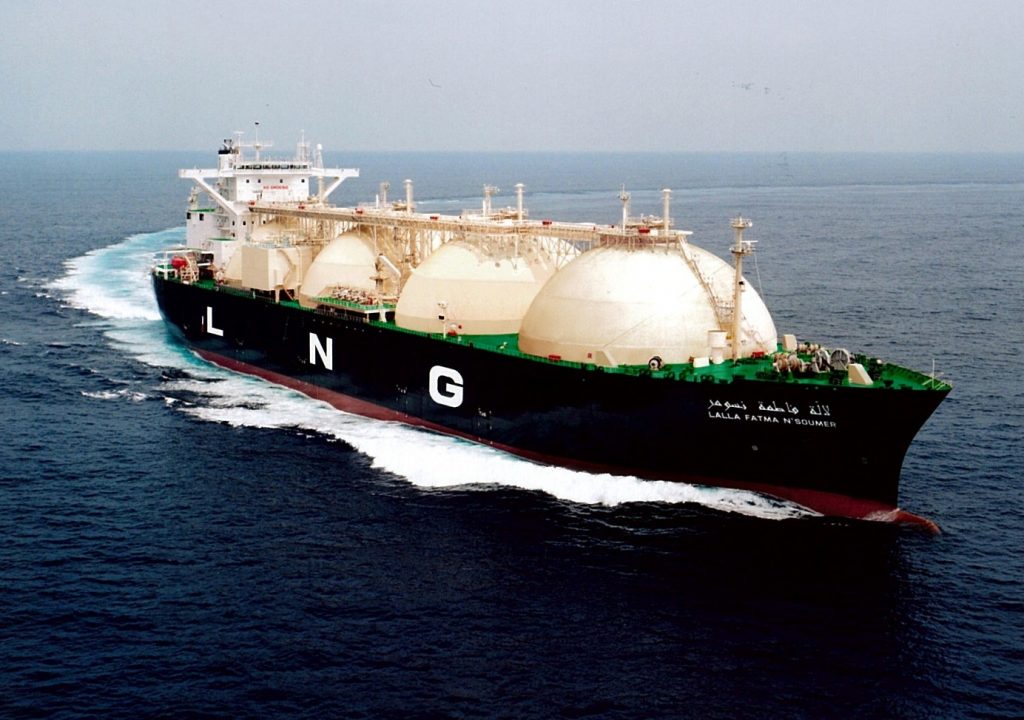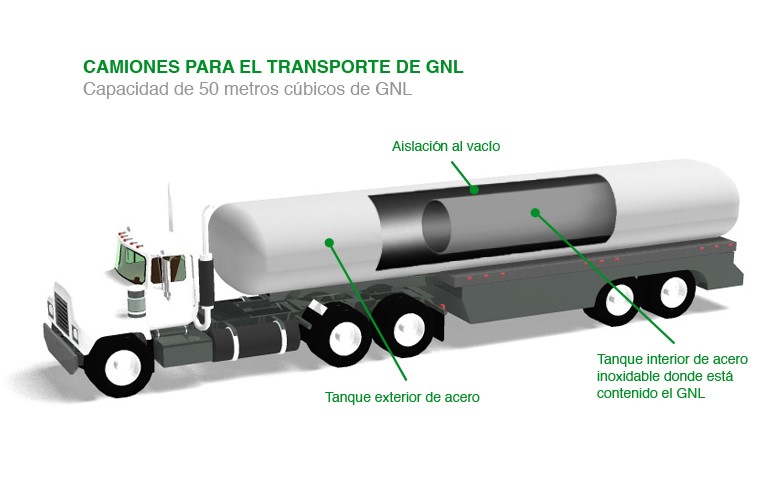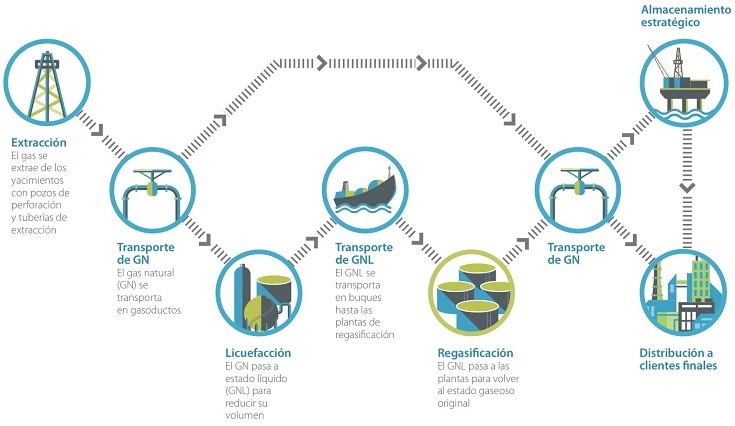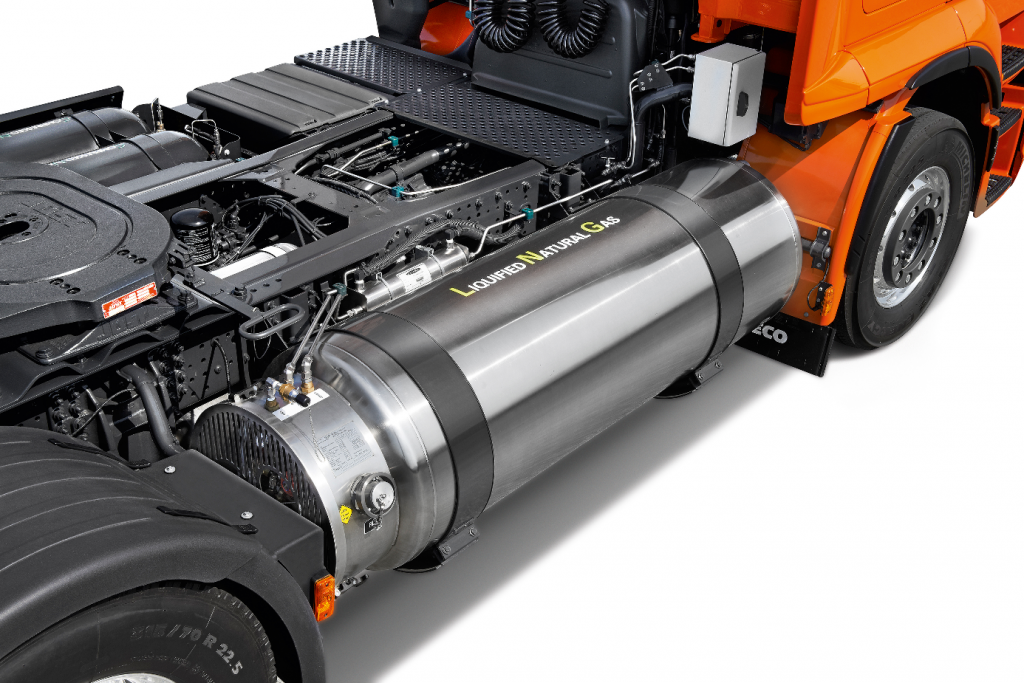Liquefied natural gas (LNG) is natural gas in liquid state. The gas is cooled to -259,6 ° F at atmospheric pressure in a process called liquefaction. During this process, the gas condenses and becomes an odorless, colorless and cryogenic liquid. In addition, carbon dioxide, oxygen, water and the sulfur compounds that make up natural gasare eliminated.
The main consequence of liquefaction is the decrease in the volume of gas, which makes transportation and storage cheaper. This facilitates its use through satellite regasification plants in isolated or remote areas where distribution networks do not exist, and it is cheaper than bringing natural gas there by gas pipeline.
Liquefied natural gas is transported from the liquefaction facility to the gasification plants in special vessels called methane tankers.

Land way transportation of liquefied natural gas is carried out with suitable fortransport tanks from the storage plants to the regasification plants.

Main features
- Liquefied natural gas is 85% methane. It also contains traces of pentanes, heptanes, ethane, propane, butane, etc.
- If liquefied natural gas meets ambient temperature, it suddenly evaporates and occupies 600 times its volume. It is extremely flammable in these conditions.
- Its energy value is higher than that of other fuels, such as propane, diesel and fuel, and the cost per kWh is lower.
- Its use as a transport fuel reduces CO2 and nitrogen oxides (NOx) emissions by 70% and does not produce sulfur compounds or particles.
- It has the lowest environmental impact of all fossil fuels, thanks to the high hydrogen-carbon ratio of its composition.
- Liquefied natural gas is not toxic or corrosive. It floats on water as it has lower density, so, in case of spillage, it evaporates and leaves no residue.
- Liquefied natural gas suddenly evaporated is less dense than air, so it rises and disperses easily in the atmosphere. Therefore, it does not contaminate water or soil.
- It is a type of non-renewable energy, so it is limited in nature.
Gas chain
Approximately half of the hydrocarbon reserves known today are natural gas deposits. To transport it over long distances, it is cheaper to use ships. First it is necessary to liquefy it, since at ambient temperature and atmospheric pressure it occupies a considerable volume.
Once the destination is reached, liquefied natural gas reaches the regasification plants, where it is returned to its original gaseous state, or it is still liquefied and transported to satellite regasification plants for its subsequent return to the gaseous state and distribution.

Gas chain. Source: Enagás.
LNG History
First gas liquefaction experiments date back to the 19th century and were carried out by the British physicist and chemist Michael Faraday. In 1873, the German engineer Karl Von Linde built the first refrigerator in Munich. First natural gas liquefaction plant was built in East Virginia in 1912, which was commissioned in 1917. First commercial liquefaction plant was built in Cleveland, Ohio in 1941.
The Methane Pioneer, the world’s first methane tanker, transported liquefied natural gas from Louisiana to the United Kingdom for the first time in January 1959. This ship was rebuilt from an old ship of the Second World War, with a capacity of 7000 barrels. It was the first sign that it was possible to safely transport large quantities of LNG by sea. First liquefaction plant was built in 1960 with a load base in Algeria. A large-scale liquefied natural gas trade between Algeria and Europe was established in 1964. Transport of LNG from Alaska to Japan was established in 1969.
LNG uses
Natural gas uses extend to industry due to its high calorific level (especially in the metallurgical, food and chemical sectors).
Liquefied Natural Gas can be used as fuel for maritime and land transportation. In maritime transport, Europe plays an important role in its expansion in the global market as ship fuel. Legislation issued by the International Maritime Organization (IMO) and by the European Commission to limit the emission of sulfur for ships is driving the search for alternative fuels at low cost. LNG has been chosen by the European Commission as “Clean fuel for transport”. In land transportation, it is used in light and heavy vehicles (especially trucks).

